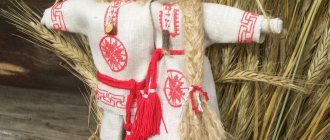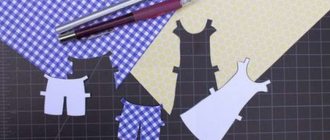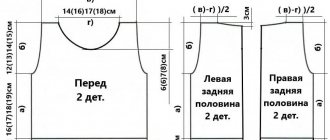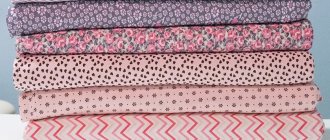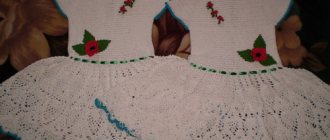The style, known as the “peasant young lady”, is loved by many. This dress with a falling neckline and puffy peasant sleeves, with a high waistline and a full long skirt, is very feminine and romantic. The pattern of a dress in the “peasant young lady” style is not particularly difficult! You will see this today.
This model has many advantages - a wide belt emphasizes the waist, making the figure more graceful and feminine, a long fluffy skirt allows you to hide overly full or thin hips and adds mystery to the image, and open shoulders and neck in most cases look very advantageous.
This is a wonderful option for a summer dress - made of natural fabric (cotton, cambric, poplin, silk or fine linen), it does not restrict movement, and it is cool in it on a hot day. In addition to convenience, such outfits always add charm to their owner, making her posture more graceful and her gait smoother. Modern dress options allow you to play with the length and choose the most comfortable option - midi, mini or maxi.
The “young lady-peasant” style is rated as uncomplicated, suitable for beginning needlewomen.
A little history
The peasant dress and similar silhouettes appeared at the end of the 18th century, when the French Revolution took place. At that time, the distinctive features for such a thing were open shoulders and neck, an emphasized waistline, a fairly full skirt and wide sleeves. Initially, the dress was called “shemiz” - from the same name for the lower long shirt. The simplicity of this silhouette was strikingly different from the luxurious and lush attire of that era. Since then, young ladies began to prefer thinner, almost transparent materials. Only a couple of layers of underwear were worn underneath. The chemise dress had an ascetic silhouette, which was achieved by a high waistline and a one-piece bodice with a skirt. Over time, the dress changed its appearance, and as for materials, they began to choose thin muslin, percale, and gauze for sewing.
In Alexander Pushkin’s work “The Peasant Young Lady,” from which the fashion designers borrowed the name for the dress, similar styles can be traced. They differ only in simpler fabrics and unpretentious patterns - almost the same look is present in modern fashion.
Advantages
The “peasant woman” dress has a lot of positive qualities, among which it is worth highlighting the main ones. Thus, the open shoulder line creates a fragile and feminine image of a sophisticated lady. From the outside it seems that the lady has a long neck and graceful shoulders. In addition, a decent neckline on the dress visually increases the volume of the breasts, which is important for ladies with “miniature” proportions. This point should also be taken into account by women with gorgeous breasts, since in this dress they will appear even larger.
The advantages of this dress model include the fact that it adds romance, innocence and tenderness to the image. And oddly enough, the style suits different ages: both a young lady and an older woman will look bright and stunning in a dress in the “peasant” style.
However, when choosing a dress, you should not ignore the texture of the fabric. Matter can both improve it and ruin it. In this case, too simple and cheap material will lead to the fact that the item will resemble a nightgown.
Consider the nuances
A “peasant woman” dress is made, the pattern of which is now of interest to many professional seamstresses, from simple and natural fabrics: cotton, cambric, linen, etc. Often on such a dress you can see folklore motifs or decor in an ethnic style. For decoration, lace inserts, puffed sleeves, and embroidery in the neckline and hem are used. Sometimes designers use drapery in the chest area to visually increase its volume.
In addition to the neckline, peasant-style dresses can emphasize the waist. To make your figure look slimmer and more graceful, the option of a cut-off skirt with the addition of a belt helps. Also, a full skirt, which may even consist of several layers or tiers of material, will give a thin waist.
How to choose the right style?
A floor-length peasant dress is considered a classic of the genre. This is the most common model among designers, and this is where it all began. Later, shortened versions appeared to the knee and above. The upper part of the product may have draperies, embossing, embroidery or frills.
Despite the fact that a dress in the “peasant lady” style is suitable for ladies of any age and with any body type, it must be chosen correctly. So, if there is a need to hide your stomach and hips, then it is better to choose a dress with a full skirt and a wide belt that will emphasize the waist, and everything else will be hidden from prying eyes. If you need to give your breasts fullness, an elegant neckline will help.
Young ladies with wide and massive shoulders are not advised to buy a dress with completely open shoulders, as this will emphasize them even more.
The highlight of the robe can be a slit (for example, on the side) - this is for those who have slender legs, as they will be visible while walking. According to stylists, it is worth choosing shoes with heels to complement the cut in order to visually lengthen your legs.
Peasant dress pattern for kids
The pattern for the front and back of the garment is for the top only. You will need to measure the length of the dress to get the length you want.
Once you have all the parts. It's time to put the sleeves on the front and back. With right sides together, sew the sleeves onto the front bodice.
Next, sew the sleeves to the back of the bodice.
Now let's add a stripe at the bottom. Cut about 30 inches of flannel that is 4 inches wide. Fold 1/4″ and then another 1/4″ for the hem. Iron. Sew right sides together. Repeat the same for the bodice on the back. ** PHOTOS OF THE SHOW FOR DISTRIBUTION. Do the same process but without collecting the strip for the strip.
The finished strip attached to the bodice will look like this:
Add a rick stand to the bottom strip.
Let's move on to the sleeves. Fold down 1/4 inch and then about 2 inches. Iron and edge. Take about 6 inches of 1/4 inch elastic and sew it to the top of the hem while pulling the elastic tight. You should pull the elastic while sewing until you reach the end. Repeat the same on the other side.
Add a rick stand to the sleeve as you did for the bottom band.
Then sew from the end of the sleeve to the end of the dress. Repeat for the other side.
Create a shell at the neck line by folding it over 1/4″ and then again about 3/4″. Sew all the way through, leaving about 2 inches to go through the elastic. Thread the elastic and sew up the opening.
That's all. I hope you enjoy the pattern.
Thanks for visiting and Happy Sewing
.
What to combine with?
The “peasant woman” dress, a photo of which is given in the article, can be easily combined with different shoes. You can choose both ballet flats and shoes or high-heeled sandals - it all depends on where you are going in this outfit. On the beach and for a daytime walk, flip-flops and ballet flats would be appropriate, but if you are going to an evening event, it is better to wear heels or shoes with a beautiful platform.
On a cool evening, it is better to add outerwear: you can wear a short bolero, cardigan or light cape. As for accessories, some stylists prefer to dilute a sophisticated and delicate dress with massive earrings, bracelets, and rings to create a contrast. Bright hair decorations will also look advantageous, but you should decorate the neck very carefully so as not to burden the image and not to cancel out all the advantages of such a flowy dress in one fell swoop.
How to cut fabric using a paper pattern
Learn how to prepare a paper pattern and then cut dress fabric ready to sew with a video tutorial from our sewing expert, Thelma Judge.
Proper preparation of a paper pattern is mandatory when learning to sew a dress. If you want a professional looking finished garment, be sure to follow our experts' tips when cutting out your paper and fabric dress patterns!
How to prepare a paper pattern
1.Remove the paper pattern from the pattern envelope and lay it out on the table. 2. Once you have chosen the size of the dress you want to sew, use a red pencil to mark the cutting guides for the selected size. This will make it easier to follow the dotted lines.
3. Use paper scissors to cut out all the pieces of paper needed for your clothes.
4. Iron the paper design over low heat to remove any wrinkles.
How to cut fabric to make a dress
1.Prepare fabric following manufacturer's washing instructions. Let the fabric dry and iron the folds before cutting. 2. Follow the layout directions in the paper pattern instructions, they will show you how to lay out the pattern on the fabric based on its width.
3. Fold the fabric in half, edge to edge, which is the neat edge of the fabric. Where the instructions say to place the paper pattern on a fold of fabric, place a piece of paper flush against the fold and secure with a pin. 4. When laying out the next pattern piece, there is a line called the grain line that should run parallel to the grain of the fabric. To make sure the paper pattern is in the correct position, use a tape measure to ensure that the line is the same distance from the fold of the fabric all the way across. 5. To transfer the notches of the design onto the fabric, mark the notches by cutting an extra piece of fabric to avoid notching the seam allowance. For double cuts, make one wider than two so that it is easy to recognize.
6. If you have a marking that needs to be transferred, push a pin through the center of the marking and make a mark with tailor's chalk. A simple tailor's bartack with contrasting thread and needle will also work. 7. Cut out the lining in the same way.
Now it's time to sew the sections of the dress together with our step-by-step video tutorial.
,
Sewing features
According to fashion designers, a fashionable peasant dress is perfect for summer and warm autumn. Its pattern is quite simple, and even beginners will not have any difficulty sewing this style. The key here is to construct the three main components of the pattern: bodice, sleeves and skirt. Before preparing the patterns, you should decide on the length of the sleeve and the style of the skirt - for example, “sun” or “tatyanka”.
For a circle skirt you need a recess pattern. Here it is recommended to prepare the front and back separately by first cutting out the dart. This will make it possible to make the waist less voluminous, and for ease of dressing, add a zipper to the side seam.
When preparing a dress with a Tatyanka skirt style, you should leave seam allowances so that you can adjust it to size during the process. So, for processing, it is advisable to add 2 cm to the length of the skirt, 6 cm to the length of the bodice and a couple of cm to the length of the sleeve.
You must first sew down the sleeves and details of the bodice, then make a drawstring along the upper cut. If desired, a drawstring can be added along the bottom of the sleeve. After trying on the bodice, the front is connected to one half of the skirt, and the back to the other. Next, the bottom of the skirt is processed to give the look fullness. The last step is making a belt, if, of course, it is provided in the model.
Material selection
At one time, only natural fabrics such as cotton or linen were used. The advantage today must be given to them. Today, other materials are also used for sewing dresses: wool, jacquard. Chintz, chiffon, poplin, silk or staple fit and look great. Light cambric can also allow you to create unique models.
Linen is an excellent choice for this type of product
Important! You can also use simple knitwear of absolutely any density and quality. The only limitation is that the knitwear has a little stretch.
Sewing will most likely require 2 to 6 meters of fabric. It all depends on the length of the product and the length of the sleeves. That is why before manufacturing it is necessary to accurately measure the amount of material required.
Raglan Peasant Dress
Simple tips
As practice shows, not all ladies are natural cutters, and not everyone has time for this, so many fashionistas are increasingly interested in how to sew a “peasant” dress without a pattern. For this purpose, many training videos and personal YouTube channels are posted on the Internet, where everything is explained and shown in great detail.
Making a “peasant woman” dress with your own hands is not difficult; you just need a little patience and skill in working with a sewing machine. Fashion stylists recommend that before sewing, first decide on the style, then choose the fabric. If you decide to sew a dress yourself, then it is better not to skimp on the material and choose a high-quality, albeit expensive one. For beginners, it is more appropriate to train on simple models so as not to spoil the material.
Layout and fabric consumption
There are two options for cutting and laying out fabric:
- If the width is 80 centimeters: two lengths of a shirt or dress + sleeve lengths. The seams in this case will be side;
- If the width is 140 - 150 centimeters: one shirt or dress length + sleeve length. There is only one seam: along the back or front.
Printed cambric is in no way inferior to cotton and linen
This is interesting: Lace dress pattern
